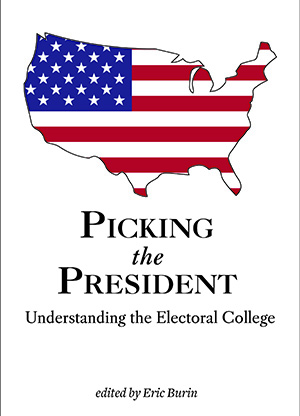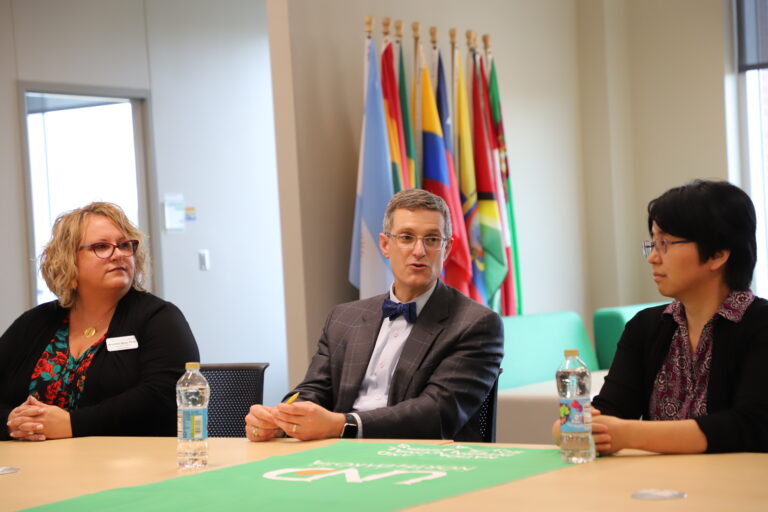‘Picking the president’ — an electoral divide
UND history professors team up to utilize digital platform for quick and timely book release on one of politics’ biggest hot-button issues

“Electoral College.”
After a tumultuous 2016 election night, the words feel like poison on the lips of some, and sound like an answered prayer for others.
Donald Trump was elected to be president by the grace of the system, having lost the election’s popular vote to Hillary Clinton by millions of ballots. Thus, the old question from the voting public resurfaced: Why do we use the Electoral College?
And as we approach the eve of the inauguration of Trump as the nation’s 43rd President of the United States, the many aspects of that question are explored by UND History Professor Eric Burin in his new book, Picking the President: Understanding the Electoral College. The publication is a collaborative digital effort that includes expert insights from UND faculty and scholars from across the country.
“In the aftermath of the election, there seemed to be widespread popular interest in the Electoral College,” Burin said. “People weighed in with blog posts, op-eds and letters to the editor. I thought this was great — I thought it showed a real interest in civic affairs. My thinking was that scholars in the humanities and social sciences could facilitate and expand that conversation.”
Picking the President takes an interdisciplinary approach to discussing one of the country’s most hotly debated systems. Burin reached out to contributors with diverse expertise in political science, math, philosophy, communication and more.
“One of the things I noticed after the election was that the interpretations and analyses of the Electoral College tended to be warped by partisanship. Republicans, since they perceived that the Electoral College advantaged their party, tended to favor it. Democrats, still smarting from losing the election, denounced it,” Burin explained. “Having a multidisciplinary approach helps us look at the Electoral College through something other than pure partisanship.”

Pressed for time
In the days following the 2016 election, Burin pitched the idea of the book to his UND history colleague, William “Bill” Caraher, who serves as director and publisher of The Digital Press at the University of North Dakota.
“Eric and I talked about it informally in the hallway,” Caraher recalled. “I find that authors and editors are often just looking for someone to give them a little nudge, and then their projects can go. It’s incredibly gratifying as a publisher to be able to give that nudge by saying, ‘This is a good idea, I’m interested in it, I’m excited about it.’”
From there, the duo worked fast, writing and gathering brief essays covering all angles of the subject, from the history of the Electoral College to possible alternatives. The Digital Press allowed them to get the book out when it was needed most.
“We wanted to not only illuminate the Electoral College, but do so while people were still talking about it,” Burin said. “Normally a book takes sometimes years to produce. This went from conception to completion in five weeks.”
“The great thing about publishing in the 21st century is that it’s now easier than ever to become familiar with the tools you need to produce high-quality publications and to disseminate them,” Caraher added. “We can basically develop a book from start to finish for almost no money and without much in the way of infrastructure.”
An informed public
Caraher expects that over the next two months the book will have a national reach. Some contributors are already using it in their classrooms well outside the borders of North Dakota.
“With books like the Picking the President, something really timely, we want to remove as many barriers as possible to get it circulating as quickly as possible,” Caraher said. “Its digital format, the fact that it’s free, and the flexible license it’s released under will ensure that that can happen.”
The minds behind the book agree that their goal was not to simply produce a comprehensive account of the Electoral College, but rather to spark further conversation among students, scholars and the community, and give them the tools necessary to become informed voters.
“Just as the University serves the needs of the state by promoting energy development and UAS and rural health, we can also serve the state’s needs by promoting thoughtful, wide-ranging and rewarding public discourse on one of the most momentous issues of the day: the Electoral College,” Burin said.
To download Picking the President: Understanding the Electoral College for free, click here.
A paperback version of the book will be available by the end of the month on Amazon.com.


